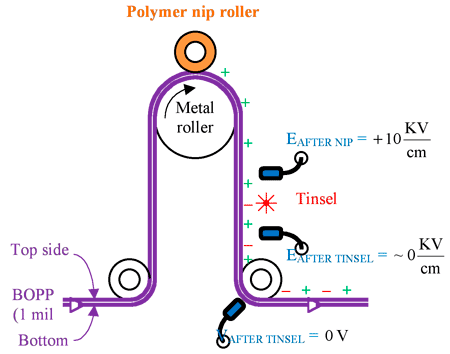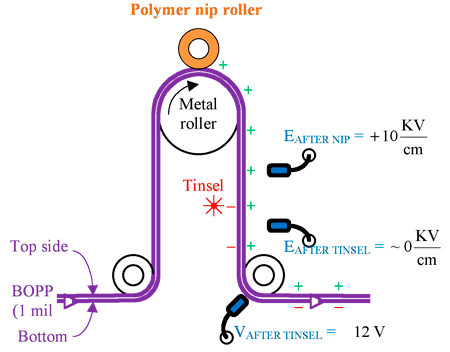Static Beat | Side Matters
- Published: February 08, 2012
When installing tinsel or a static bar near the web, does it matter which side it’s on? If so, why does side matter? Yes, side matters. It is really important to install a static dissipater on the correct side of the web to prevent winding static charge into the finished roll and winding a “hot roll.”
Look at the good performance of the tinsel in Figure 1. The 1-mil (25-m) biaxially oriented polypropylene (BOPP) web has no static before it touches the polymer nip roller. Exiting the nip roller, the BOPP web is charged. Fieldmeter reading EAFTER NIP responding to charge on both sides of the web is strongly positive: +10 KV/cm.

While the fieldmeter reading does not tell us which side is charged, we know that the charge is on the side that touched the polymer nip roller. The bottom surface has very little charge because, in my experience, the BOPP web can touch many metal rollers before accumulating measurable charge.
The tinsel responds to charge on both surfaces of the web just like a fieldmeter. With high positive charge on the web, the tinsel generates negative ions that move to the web. Fieldmeter reading EAFTER TINSEL responding to charge on both sides of the web is zero. The negative charge from the tinsel has effectively neutralized the positive static from the polymer nip roller. A non-contacting electrostatic voltmeter (ESVM) measuring VAFTER TINSEL confirms that the bottom side of the BOPP web has no charge. The web exiting this section of the conveyance path is electrically neutral. This good static performance is achieved because the tinsel in Figure 1 is located on the side that has static.
The poor static performance in Figure 2 results from the tinsel facing on the wrong side of the web. The BOPP web has no static before it touches the polymer nip roller. Exiting the nip roller, static on the surface that touched the polymer nip roller causes fieldmeter reading EAFTER NIP to be strongly positive: +10 KV/cm. And, knowing that tinsel responds to the static charge on both sides of the web just like a fieldmeter, the high positive static on the web causes the tinsel to generate negative ions that move to the web.

Just as before, EAFTER TINSEL is zero because the fieldmeter responds to charge on both sides of the web. However, the negative ions from the tinsel in Figure 2 are on the bottom surface of the web causing ESVM reading VAFTER TINSEL to be –12 volts. The web exits this section of the conveyance path with a lot of static: positive charge on the top surface from the polymer nip roller and negative charge on the bottom surface from the tinsel.
Static charge on the web causes a voltage of 12 volts, which does not seem like very much. However, this charge pattern of positive charge on one surface with an equal amount of negative charge on the other surface is very difficult to neutralize and will persist all the way to the winding roll.
After winding the first lap, the voltage on the winding roll will be 12 volts. After the second lap, the voltage will be 24 volts. And, after 1,000 laps are wound, which will have a thickness of only about 1 in. on the core, the voltage on the winding roll will be 24 KV. This is sufficient to cause static discharges and audible crackling.
Static from the polymer nip roller was not neutralized by the tinsel located on the wrong side. Instead, positive static from the polymer nip roller and negative charge from the tinsel cause the winding roll to have high static. The hot roll is caused by having the static dissipater facing on the wrong side of the web.
Side matters. To neutralize static, locate the tinsel, ionizing string, or static bar facing the side of the web that has static. Following a nip roller, static will be on the side that touched the polymer nip roller.
I invite you to ask questions about this column and to suggest topics for a future Static Beat. My e-mail address is: Kelly.Robinson@ElectrostaticAnswers.com.
Static control expert Dr. Kelly Robinson, president of Electrostatic Answers, has 27+ years of experience in problem-solving and consulting. Contact him at 585-425-8158; kelly.robinson@electrostaticanswers.com; www.electrostaticanswers.com.














